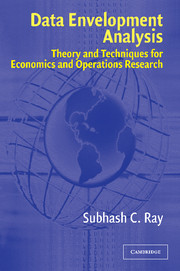Book contents
- Frontmatter
- Contents
- Preface
- 1 Introduction and Overview
- 2 Productivity Efficiency, and Data Envelopment Analysis
- 3 Variable Returns to Scale: Separating Technical and Scale Efficiencies
- 4 Extensions to the Basic DEA Models
- 5 Nonradial Models and Pareto–Koopmans Measures of Technical Efficiency
- 6 Efficiency Measurement without Convexity Assumption: Free Disposal Hull Analysis
- 7 Dealing with Slacks: Assurance Region/Cone Ratio Analysis, Weak Disposability, and Congestion
- 8 Efficiency of Merger and Breakup of Firms
- 9 Efficiency Analysis with Market Prices
- 10 Nonparametric Approaches in Production Economics
- 11 Measuring Total Productivity Change over Time
- 12 Stochastic Approaches to Data Envelopment Analysis
- 13 Looking Ahead
- References
- Index
7 - Dealing with Slacks: Assurance Region/Cone Ratio Analysis, Weak Disposability, and Congestion
Published online by Cambridge University Press: 24 November 2009
- Frontmatter
- Contents
- Preface
- 1 Introduction and Overview
- 2 Productivity Efficiency, and Data Envelopment Analysis
- 3 Variable Returns to Scale: Separating Technical and Scale Efficiencies
- 4 Extensions to the Basic DEA Models
- 5 Nonradial Models and Pareto–Koopmans Measures of Technical Efficiency
- 6 Efficiency Measurement without Convexity Assumption: Free Disposal Hull Analysis
- 7 Dealing with Slacks: Assurance Region/Cone Ratio Analysis, Weak Disposability, and Congestion
- 8 Efficiency of Merger and Breakup of Firms
- 9 Efficiency Analysis with Market Prices
- 10 Nonparametric Approaches in Production Economics
- 11 Measuring Total Productivity Change over Time
- 12 Stochastic Approaches to Data Envelopment Analysis
- 13 Looking Ahead
- References
- Index
Summary
Introduction
The presence of any positive input or output slacks at the optimal solution of a CCR or BCC DEA model has already been recognized as a potential problem with the technical efficiency measure in such cases. The nonradial models considered in Chapter 5 ensure that no slacks are present at the projection of an observed input or output bundle onto the isoquant. In this chapter, we consider several other approaches that address the problem of slacks. It may be noted that when a slack is present at the optimal solution, the relevant input or output constraint is nonbinding and the shadow price of the resource (i.e., the dual variable associated with the constraint) equals 0. An alternative approach known as assurance region (AR) analysis avoids the problem of slacks by imposing restrictions on the shadow prices of inputs and or outputs. This leads to a reconstruction of the input or output isoquant in such a way that no slacks can exist at the radial projection of any input or output bundle onto the modified isoquant. Use of prior weight restrictions also allows incorporation of expert opinion regarding the relative significance of individual inputs and outputs in the production process.
The approach of AR analysis was introduced by Thompson, Singleton, Thrall, and Smith (1986) and was applied for choosing a “best site” for the location of a high-energy physical laboratory.
Information
- Type
- Chapter
- Information
- Data Envelopment AnalysisTheory and Techniques for Economics and Operations Research, pp. 159 - 186Publisher: Cambridge University PressPrint publication year: 2004
